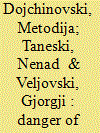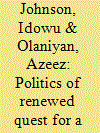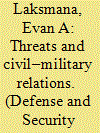|
|
|
Sort Order |
|
|
|
Items / Page
|
|
|
|
|
|
|
| Srl | Item |
| 1 |
ID:
156561


|
|
|
|
|
| Summary/Abstract |
The building of reliable covers has always been of the utmost importance for clandestine Humint. Using both primary and secondary sources, this study seeks to examine how classical authors and modern scholars have dealt with this topic, and which kind of covers have been the most used throughout history in different sociopolitical contexts, and what are the new perspectives for today’s challenges. Findings suggest that a careful reading of the political milieu in which intelligence officers are required to work, and a certain degree of creativity, are the essential premises for the construction of a plausible cover; that some apparently outdated disguises such as merchants, itinerant monks and philosophers should be understood more broadly today to include business people, humanitarian NGOs and academics; that undercover practices have been theoretically and historically recognized as necessary and convenient by a great number of societies, often with scant regard for ethical considerations.
|
|
|
|
|
|
|
|
|
|
|
|
|
|
|
|
| 2 |
ID:
156555


|
|
|
|
|
| Summary/Abstract |
The term “hybrid warfare” is a new one that the West began to use to explain its failure to cope with asymmetric threats. Focusing on the war on global terrorism, the West temporarily withdrew its attention from traditional adversaries, such as Russia, which has used this gap and has audaciously returned to the stage as a global actor. Until the Russian annexation of the Crimean Peninsula in 2014 and inflaming the Ukrainian crisis, most Western authors attributed “hybrid threats” mostly to non-state actors. But the Ukrainian scenario showed the true face of “hybridity” in the modern battlefield when practised by a powerful state actor. Russian “hybrid warfare” in Ukraine has already been seen as a combination of conventional and unconventional methods, that have been complemented with other instruments of national power – diplomatic, economic and information. The purpose of this article is, through an analysis of the Ukrainian scenario, to demonstrate that although the term “hybrid” is new, the concept itself is old and is a continuation of already seen doctrine from the Cold War era. Although “hybrid threats” can come both from state and non-state actors, the Russian interference in Ukraine is proof that they are especially dangerous for the West if, or when, they are initiated from a traditional, sophisticated adversary that has the capacity to use all forms of warfare.
|
|
|
|
|
|
|
|
|
|
|
|
|
|
|
|
| 3 |
ID:
156560


|
|
|
|
|
| Summary/Abstract |
The Caucasus has been a major flashpoint of contention between NATO and a resurgent Russia since the collapse of the Soviet Union. The rivalry saw the escalation of hostility in the region during the brief 2008 Russo-Georgian War where a NATO-backed Georgia challenged South Ossetia supported by the Russian military. In 2011, NATO officially recognised Georgia as a potential member, challenging Russia’s traditional sphere of influence in the Caucasus. Moscow says the Eastward expansion of NATO into the Baltics and to include Georgia as a member state is a method of containing a resurgent Russia. However, the former Soviet Republics of Ukraine, the Baltics and Georgia, maintain that Russia represents a threat to their sovereignty, as seen by the Russian support of the breakaway unrecognised Republics of South Ossetia and Abkhazia. A hostile rivalry between the Russian-backed Armenia and Azerbaijan, which is reliant upon NATO-member Turkey, intensifies the polarisation in the Caucasus.
|
|
|
|
|
|
|
|
|
|
|
|
|
|
|
|
| 4 |
ID:
156558


|
|
|
|
|
| Summary/Abstract |
With the Canada First Defence Strategy, Canada has put forth a major opportunity to reconcile national security imperatives and industrial policy. The Jenkins Report (2013) set out to examine ways to use that procurement effort to foster key industrial capabilities (KICs) that would put the Canadian defence industry at an advantage both nationally and internationally. The Canadian defence industry should then develop highly focused capabilities with a view to moving up global value chains. As such, KICs that hold the best potential should be selected. They should be sustained through a range of strategies that are however contingent on the elimination of policy gaps. This leads to a balancing act between the need to control intellectual property assets versus accessing them in a world where national boundaries are eroded. Canada’s industry should target opportunities outside North America while continuing to focus on better integration with the North American industry.
|
|
|
|
|
|
|
|
|
|
|
|
|
|
|
|
| 5 |
ID:
156557


|
|
|
|
|
| Summary/Abstract |
The quest for a Biafran Republic by the Igbo ethnic group has become a recurring demand in Nigeria since the late 1960s. The agitation has been premised on claims of marginalisation and exclusion of the Igbo people in the Nigerian body politic. In spite of the consistency of the agitation through various Administrations, there was a noticeable lull in such demands during the time of President Goodluck Jonathan, only to assume a frightening proportion since the advent of the Administration of President Muhammadu Buhari. This article locates the factors in the outcomes of the 2015 general elections: the question of inclusion and representation; the unfinished nature of the Nigerian civil war; economic challenges, miscalculation both on the part of the Igbo people and indiscretion in the initial appointments made by President Muhammadu Buhari. The article recommends political restructuring of Nigeria as one of the ways to address secessionist tendencies.
|
|
|
|
|
|
|
|
|
|
|
|
|
|
|
|
| 6 |
ID:
156559


|
|
|
|
|
| Summary/Abstract |
This article explains why Singapore, despite its small size and semi-authoritarian regime, retains one of the best military forces in the Indo-Pacific. It unpacks Singapore’s ability to continuously innovate since the 1960s – technologically, organizationally, and conceptually – and even recently joined the Revolution in Military Affairs bandwagon. Drawing from the broader military innovation studies literature, this article argues evolutionary peacetime military innovation is more likely to occur in a state with a unified civil–military relation and whose military faces a high-level diverse set of threats. This argument explains how the civil–military fusion under the People’s Action Party-led government since Singapore’s founding moment has been providing coherent and consistent strategic guidance, political support, and financial capital, allowing the Singapore Armed Forces to continuously innovate in response to high levels and diversity of threats.
|
|
|
|
|
|
|
|
|
|
|
|
|
|
|
|
| 7 |
ID:
156556


|
|
|
|
|
| Summary/Abstract |
Turkey is the only Eurasian state surrounded in almost a full circle by acute hot or “frozen conflicts,” ranging from low-intensity violence, terrorism to fully fledged wars. The prevailing pattern of intercommunal and interethnic conflicts in the continental Balkans and on Cyprus has long been different from those in the rest of Europe and in the Near East. This difference is closely related to the fact that these lands had experienced in the past centuries-long rule by the Ottoman Empire, whose legal successor is the Republic of Turkey. The intercommunal conflict potential in the rest of Europe used to differ substantially, but the difference has been greatly reduced as Western Europe has, in one respect, become “balkanized.”
|
|
|
|
|
|
|
|
|
|
|
|
|
|
|
|
|
|
|
|
|